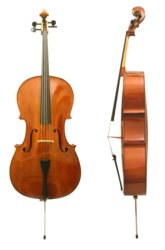
Back Tjello Afrikaans Violoncello ALS كمان جهير Arabic تشيللو ARZ Violonchelu AST Violonçel Azerbaijani Stehgeign BAR Віяланчэль Byelorussian Віялянчэль BE-X-OLD Виолончело Bulgarian
This article needs additional citations for verification. (January 2023) |
 Cello, front and side view. | |
| String instrument | |
|---|---|
| Other names | Violoncello |
| Hornbostel–Sachs classification | 321.322-71 (Composite chordophone sounded by a bow) |
| Developed | c. 1660 from bass violin |
| Playing range | |
 | |
| Related instruments | |
| Sound sample | |
|
| |
The violoncello (/ˌvaɪələnˈtʃɛloʊ/ VY-ə-lən-CHEL-oh, Italian pronunciation: [vjolonˈtʃɛllo]),[1] normally simply abbreviated as cello (/ˈtʃɛloʊ/ CHEL-oh), is a middle pitched bowed (sometimes plucked and occasionally hit) string instrument of the violin family. Its four strings are usually tuned in perfect fifths: from low to high, C2, G2, D3 and A3. The viola's four strings are each an octave higher. Music for the cello is generally written in the bass clef, tenor clef, alto clef and treble clef used for higher-range passages.
Played by a cellist or violoncellist, it enjoys a large solo repertoire with and without accompaniment, as well as numerous concerti. As a solo instrument, the cello uses its whole range, from bass to soprano, and in chamber music, such as string quartets and the orchestra's string section, it often plays the bass part, where it may be reinforced an octave lower by the double basses. Figured bass music of the Baroque era typically assumes a cello, viola da gamba or bassoon as part of the basso continuo group alongside chordal instruments such as organ, harpsichord, lute, or theorbo. Cellos are found in many other ensembles, from modern Chinese orchestras to cello rock bands.
- ^ "violoncello noun – Pronunciation". Oxfordlearnersdictionaries.com. Retrieved October 4, 2016.